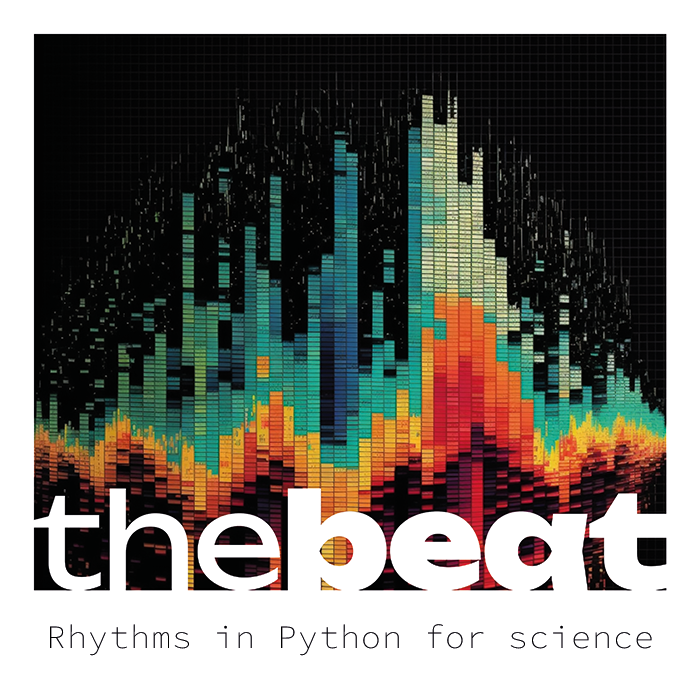Utilities#
These are helper functions that are used throughout the package.
- thebeat.utils.concatenate_sequences(sequences, name=None)[source]#
Concatenate an array or list of
Sequenceobjects.Note
Only works for Sequence objects where all but the last provided object has an
end_with_interval=Trueflag.- Parameters:
sequences (
Union[_SupportsArray[dtype[Any]],_NestedSequence[_SupportsArray[dtype[Any]]],bool,int,float,complex,str,bytes,_NestedSequence[Union[bool,int,float,complex,str,bytes]]]) – The to-be-concatenated objects.name (
Optional[str], default:None) – Optionally, you can give the returned Sequence object a name.
- Returns:
The concatenated Sequence
- Return type:
- thebeat.utils.concatenate_soundsequences(sound_sequences, name=None)[source]#
Concatenate an array or list of
SoundSequenceobjects.Note
Only works for SoundSequence objects where all but the last provided object has an
end_with_interval=Trueflag.- Parameters:
sound_sequences (
Union[_SupportsArray[dtype[Any]],_NestedSequence[_SupportsArray[dtype[Any]]],bool,int,float,complex,str,bytes,_NestedSequence[Union[bool,int,float,complex,str,bytes]]]) – The to-be-concatenated objects.name (
Optional[str], default:None) – Optionally, you can give the returned SoundSequence object a name.
- Returns:
The concatenated SoundSequence
- Return type:
- thebeat.utils.concatenate_soundstimuli(sound_stimuli, name=None)[source]#
Concatenate an array or list of
SoundStimulusobjects.
- thebeat.utils.get_ioi_df(sequences, additional_functions=None)[source]#
This function exports a Pandas
pandas.DataFramewith information about the providedthebeat.core.Sequenceobjects in tidy data format. The DataFrame always has the columns:Sequence_index: The index of the Sequence object in the list of Sequences.IOI_i: The index of the IOI in the Sequence.IOI: The IOI.
Additionally it has a column
Sequence_nameif at least one of the provided Sequence objects has a name.Moreover, one can provide a list of functions that will be applied to each sequence’s IOIs. The results will be added as additional columns in the output DataFrame. See under ‘Examples’ for an illustration.
- Parameters:
sequences (
Sequence|list[Sequence] |ndarray[Sequence]) – The Sequence object(s) to be exported.additional_functions (
Optional[list[callable]], default:None) – A list of functions that will be applied to the IOIs for each individual sequence, and the results of which will be added as additional columns.
- Returns:
A Pandas DataFrame with information about the provided Sequence objects in tidy data format.
- Return type:
pd.DataFrame
Examples
>>> rng = np.random.default_rng(123) >>> seqs = [thebeat.core.Sequence.generate_random_normal(n_events=10, mu=500, sigma=25, rng=rng) for _ in range(10)] >>> df = get_ioi_df(seqs) >>> print(df.head()) sequence_i ioi_i ioi 0 0 0 475.271966 1 0 1 490.805334 2 0 2 532.198132 3 0 3 504.849360 4 0 4 523.005772
>>> import numpy as np >>> df = get_ioi_df(seqs, additional_functions=[np.mean, np.std]) >>> print(df.head()) sequence_i mean std ioi_i ioi 0 0 503.364499 17.923263 0 475.271966 1 0 503.364499 17.923263 1 490.805334 2 0 503.364499 17.923263 2 532.198132 3 0 503.364499 17.923263 3 504.849360 4 0 503.364499 17.923263 4 523.005772
- thebeat.utils.get_major_scale(tonic, octave)[source]#
Get the major scale for a given tonic and octave. Returns a list of
abjad.pitch.NamedPitchobjects.Note
This function requires abjad to be installed. It can be installed with
pip install abjadorpip install thebeat[music_notation]. For more details, see https://thebeat.readthedocs.io/en/latest/installation.html.- Parameters:
- Returns:
A list of
abjad.pitch.NamedPitchobjects.- Return type:
pitches
- thebeat.utils.merge_sequences(sequences, name=None)[source]#
Merge an array or list of
Sequenceobjects. The the event onsets in each of the objects will be overlaid on top of each other.- Parameters:
sequences – The to-be-merged objects.
name (default:
None) – Optionally, you can give the returned Sequence object a name.
- Returns:
The merged Sequence
- Return type:
- thebeat.utils.merge_soundsequences(sound_sequences, name=None)[source]#
Merge a list or array of
SoundSequenceobjects. The event onsets in each of the objects will be overlaid on top of each other, after which the sounds- Parameters:
sound_sequences (
list[SoundSequence]) – The to-be-merged objects.name (
Optional[str], default:None) – Optionally, you can give the returned SoundSequence object a name.
- Returns:
The merged SoundSequence
- Return type:
- thebeat.utils.merge_soundstimuli(sound_stimuli, name=None)[source]#
Merge an array or list of
SoundStimulusobjects. The sound samples for each of the objects will be overlaid on top of each other.- Parameters:
sound_stimuli – The to-be-merged objects.
name (default:
None) – Optionally, you can give the returned SoundStimulus object a name.
- Returns:
The merged SoundStimulus
- Return type:
